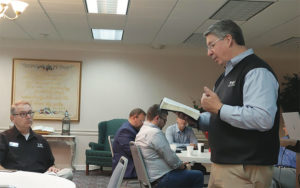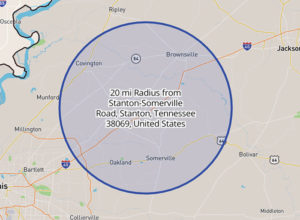Baptists prepare for massive opportunities at plant
By Lonnie Wilkey
Editor, Baptist and Reflector
lwilkey@tnbaptist.org

An artist’s rendering of the to-be-constructed Ford plant, which will be called Blue Oval City, in Stanton.
BROWNSVILLE — Tennessee Baptists are on “the front porch” of a population explosion in West Tennessee that will bring thousands of people to the Volunteer State, said Danny Sinquefield, Harvest Field 1 team leader for the Tennessee Baptist Mission Board.
Harvest Field 1 includes Beulah, Dyer, Gibson County, Crockett County, Big Hatchie, Haywood, Madison-Chester, Mid-South, Fayette County, Hardeman County and Shiloh Baptist associations.
In September of 2021, Ford Motor Company, along with SK Innovations of Korea, announced plans to construct Blue Oval City, a $5.6 billion project to produce electric trucks and electric batteries at the 4,100-acre site in Stanton (Haywood County), formerly known as the Memphis Regional Megasite. It will be the largest automobile manufacturing plant in the nation, according to projections.
The project is expected to create 6,000 new jobs at the plant with another 2,000-3,000 jobs in various support plants/industries that will be located in the region. In addition, The Commercial Appeal in Memphis reported that 3,000 workers are expected to begin construction by year’s end and that number could increase to 8,000 workers by summer of 2023. Those numbers do not include family members who would join the workers.

Danny Sinquefield, team leader for Harvest Field 1 for the Tennessee Baptist Mission Board, shares a brief devotion prior to the “Blue Oval City Coalition” held Feb. 22 at Brownsville Baptist Church, Brownsville. — Photo by Lonnie Wilkey
The Tennessee Baptist Mission Board hosted a “Blue Oval City Coalition” on Feb. 22 at Brownsville Baptist Church to discuss church planting and church revitalization that is necessary for the massive population increase in West Tennessee.
Describing the meeting as “historic,” Sinquefield emphasized the need for churches to be healthy in order “to reach and embrace the new people and also to strategically plant new churches in partnership together.
“We do not want to miss this opportunity,” Sinquefield said.
Randy C. Davis, president and executive director of the TBMB, said he is confident that Tennessee Baptists will answer the call.
“By working in collaboration and cooperation with a number of churches and associations, Tennessee Baptists will be ready to have an enormous impact with the Gospel on the population explosion expected by the building of this mega-Ford plant in West Tennessee,” he said.
“It is exciting that God has presented us with this incredible opportunity and together we will urgently move forward with a church planting and strengthening plan in the region of the ‘Blue Oval City’,” Davis added.
Sinquefield reminded the approximately 30 pastors, directors of missions and church leaders who attended the meeting that the TBMB does not plant or revitalize churches. That can only be done by the local church, he stressed.
Sinquefield, along with William Burton and Kevin Minchey of the TBMB staff, stressed that churches and associations must begin immediately to plan for the increased population growth.

This map shows the proposed location of the new Ford plant (Blue Oval City) that is to be located in Stanton in Haywood County.
Minchey, church revitalization specialist, observed that Baptists did not plan ahead when General Motors opened its Saturn Plant in Spring Hill in 1990. The population of the town then was 1,400. By 2020, the population had grown to 50,005 people, Minchey said. Existing churches in the area were not prepared for the large increase in population, he noted.
Burton, new churches team leader, agreed. “We have been playing catch up ever since,” he noted, adding that on any given Sunday, approximately 35,000 of those folks in Spring Hill are sitting at home instead of going to church.
In 2020, the population of Brownsville, the closest large town to Stanton stood at 9,788, according to Lewis McMullen, church planting specialist for the TBMB. It is expected to grow to 20,000 in 2030; 42,300 in 2040; and 72,847 by 2050.
He noted that the projections were compiled by Burton, based on what happened at the Saturn Plant in Spring Hill. Because Blue Oval City will employ approximately 40 percent more people than the Saturn Plant, actual numbers could be 20-25 percent higher than projected, McMullen said.
The state of Tennessee and county governments in the region have yet to make their official projections, McMullen added.
Minchey encouraged church and associational leaders to begin now “to cast a new vision, to dream a new dream.
“Teach your churches to pray for people before they move into the community. Prepare for a harvest,” he said.
Minchey cited several ways that church growth strategist George Bullard suggested churches can respond to their changing community.
1. Remain in the community, without changing.
2. Remain without changing, but willing to plant a new church.
3. Remain, with a “two community” approach, those who were already there and those who move in.
4. Remain and be willing to change as the community changes.
5. Relocate.
6. Disband.
Minchey cautioned that there will be people who resist the changes. “There will be adversity,” Minchey predicted, but he reminded them that God is bringing the new people to the state. “He has given us a Great Commission mandate.”
Burton also exhorted the pastors and directors of missions “to dream big and ask God for what seems impossible.”
Burton noted that Blue Oval City also will provide an opportunity “to reach the nations” as a large number of the work force, especially on the construction side, will be Hispanic or other nationalities.
He thanked the church and association leaders for their participation in the coalition. “When we all work together, we can accomplish great things for the kingdom of God,” he said.
Burton reminded those present that they may not see the results of their efforts now. “You are planting trees whose shade you may never enjoy, but someone will.” B&R
